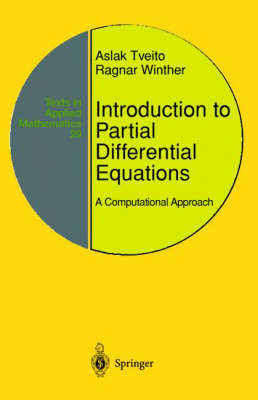
Introduction to Partial Differential Equations
A Computational Approach
Seiten
1998
Springer-Verlag New York Inc.
978-0-387-98327-1 (ISBN)
Springer-Verlag New York Inc.
978-0-387-98327-1 (ISBN)
- Titel ist leider vergriffen;
keine Neuauflage - Artikel merken
This volume blends both the numerical simulation and the analysis of Partial Differential Equations. It includes the classical topics as they should appear in a PDE course. The well-organized exercises and projects should help students with the correct way of approaching problems in PDEs.
This book teaches the basic methods of partial differential equations and introduces related important ideas associated with the analysis of numerical methods for those partial differential equations. Standard topics such as separation of variables, Fourier analysis, maximum principles and energy estimates are included. Numerical methods are introduced in parallel to the classical theory. The numerical experiments are used to illustrate properties of differential equations and theory for finite difference approximations is developed. Numerical methods are included in the book to show the significance of computations in partial differential equations and to illustrate the strong interaction between mathematical theory and the development of numerical methods. Great care has been taken throughout the book to seek a sound balance between the analytical and numerical techniques. The authors present the material at an easy pace with well-organized exercises ranging from the straightforward to the challenging. In addition, special projects are included, containing step by step hints and instructions, to help guide students in the correct way of approaching partial differential equations.
The text would be suitable for advanced undergraduate and graduate courses in mathematics and engineering. Necessary prerequisites for this text are basic calculus and linear algebra. Some elementary knowledge of ordinary differential equations is also preferable.
This book teaches the basic methods of partial differential equations and introduces related important ideas associated with the analysis of numerical methods for those partial differential equations. Standard topics such as separation of variables, Fourier analysis, maximum principles and energy estimates are included. Numerical methods are introduced in parallel to the classical theory. The numerical experiments are used to illustrate properties of differential equations and theory for finite difference approximations is developed. Numerical methods are included in the book to show the significance of computations in partial differential equations and to illustrate the strong interaction between mathematical theory and the development of numerical methods. Great care has been taken throughout the book to seek a sound balance between the analytical and numerical techniques. The authors present the material at an easy pace with well-organized exercises ranging from the straightforward to the challenging. In addition, special projects are included, containing step by step hints and instructions, to help guide students in the correct way of approaching partial differential equations.
The text would be suitable for advanced undergraduate and graduate courses in mathematics and engineering. Necessary prerequisites for this text are basic calculus and linear algebra. Some elementary knowledge of ordinary differential equations is also preferable.
Setting the scene * Two-point boundary value problems * The heat equation * Finite difference schemes * The wave equation * Maximum principles * Poisson's equation in two space dimensions * Orthogonality and general Fourier series * Convergence of Fourier series * The heat equation revisited * Reaction-Diffusion Equations * Applications of the Fourier transform * References * Index.
| Erscheint lt. Verlag | 24.7.1998 |
|---|---|
| Reihe/Serie | Texts in Applied Mathematics ; Vol.29 |
| Zusatzinfo | 69 figures, references, index |
| Verlagsort | New York, NY |
| Sprache | englisch |
| Maße | 156 x 234 mm |
| Gewicht | 754 g |
| Einbandart | gebunden |
| Themenwelt | Mathematik / Informatik ► Mathematik ► Analysis |
| ISBN-10 | 0-387-98327-9 / 0387983279 |
| ISBN-13 | 978-0-387-98327-1 / 9780387983271 |
| Zustand | Neuware |
| Haben Sie eine Frage zum Produkt? |
Mehr entdecken
aus dem Bereich
aus dem Bereich
Band 5: Hydraulik, Stromfadentheorie, Wellentheorie, Gasdynamik
Buch | Softcover (2024)
De Gruyter Oldenbourg (Verlag)
CHF 83,90


